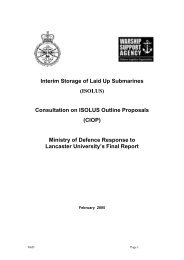Part III - Historical Survey of the Porton Down Service Volunteer ...
Part III - Historical Survey of the Porton Down Service Volunteer ...
Part III - Historical Survey of the Porton Down Service Volunteer ...
You also want an ePaper? Increase the reach of your titles
YUMPU automatically turns print PDFs into web optimized ePapers that Google loves.
G Agent Exposure Range mg.min/m 3<br />
GA 1.8 - 9<br />
GD 1 - 5.1<br />
6.6 - 10.1*<br />
GE 5 - 14<br />
GF 2.25 - 14<br />
* Men exposed to <strong>the</strong>se levels wore oro-nasal respirators.<br />
Table 8.1. Agents o<strong>the</strong>r than GB in "Aggressiveness study"<br />
The GB work in <strong>the</strong> aggressiveness study was split into two [43]. The first part involved<br />
exposures <strong>of</strong> 1.4 to 13.9 mg.min/m 3 and involved 48 men. Most <strong>of</strong> <strong>the</strong> men were exposed<br />
without protection, while some wore oro-nasal respirators to prevent inhalation. The second<br />
part considered only <strong>the</strong> eye effects <strong>of</strong> GB vapour. Fifty seven men wearing oro-nasal<br />
respirators were exposed to 7.3 - 36.7 mg.min/m 3 .<br />
The important result <strong>of</strong> <strong>the</strong> second part <strong>of</strong> <strong>the</strong> study with GB was that <strong>the</strong> effects induced<br />
showed little variation over 14-36.7 mg.min/m 3 , suggesting that <strong>the</strong> lowest point in this range<br />
was sufficient to inhibit completely local ChE in <strong>the</strong> eye. Toge<strong>the</strong>r with results from <strong>the</strong> first<br />
part <strong>of</strong> <strong>the</strong> GB study and <strong>the</strong> earlier 1949 study, <strong>the</strong> conclusions drawn were that [27, 43]:<br />
• <strong>the</strong> threshold dose for inducing miosis by GB vapour was 1.4 - 4.5 mg.min/m 3 ;<br />
• GB vapour at 6.5 -11.5 mg.min/m 3 would harass, but not cause casualties;<br />
• larger doses would not induce greater effects on <strong>the</strong> eye and, <strong>the</strong>refore, that<br />
casualties would not arise solely from eye effects.<br />
The first part <strong>of</strong> <strong>the</strong> GB element <strong>of</strong> <strong>the</strong> aggressiveness study produced an important indication<br />
about <strong>the</strong> maximum safe vapour dose. Three men were exposed with no protection to a GB<br />
vapour at 13.9 mg.min/m 3 (t = 1.5 mins). All three suffered severe eye symptoms, and also<br />
suffered persistent tightness <strong>of</strong> <strong>the</strong> chest, with nausea and vomiting (<strong>the</strong>se symptoms were<br />
deemed be early signs <strong>of</strong> systemic poisoning):<br />
• One <strong>of</strong> <strong>the</strong> three men, aged 37, was confined to bed under supervision. Red<br />
Blood Cell (RBC) and plasma ChE measurements were taken and compared to<br />
normal values for <strong>the</strong> general population. The comparison showed a "marked<br />
ChE inhibition". The minimum level <strong>of</strong> RBC ChE, six days after exposure, was 60<br />
Warburg units 3 compared to a normal lower limit <strong>of</strong> 90 Warburg units.<br />
• RBC ChE was measured in <strong>the</strong> o<strong>the</strong>r two men exposed to this dose. The<br />
minimum levels in <strong>the</strong>se two cases were 71 units and 74 units.<br />
The conclusion drawn in <strong>the</strong> report on <strong>the</strong>se experiments was that a GB vapour dose <strong>of</strong><br />
"14 mg.min/m 3 may be near to <strong>the</strong> maximum which men, even breathing quietly, may be<br />
safely exposed to without protection" [43]. The results <strong>of</strong> <strong>the</strong> first part <strong>of</strong> <strong>the</strong> work were<br />
available for <strong>the</strong> report published in August 1950 [27], which noted that a marked fall in ChE<br />
levels was observed at 13.9 mg.min/m 3 and concluded that GB vapour at 15 mg.min/m 3<br />
cannot "be far removed from <strong>the</strong> lower limit <strong>of</strong> <strong>the</strong> zone <strong>of</strong> incapacitation" [27].<br />
8.4.4. Lethal dose estimation<br />
The possibility <strong>of</strong> linking blood ChE inhibition and symptoms raised by this research<br />
suggested fur<strong>the</strong>r work to link <strong>the</strong> degree <strong>of</strong> ChE inhibition and <strong>the</strong> GB vapour dose inhaled.<br />
3 As explained in Annex C, ChE was measured by various methods. The units used cited <strong>the</strong> method:<br />
here, <strong>the</strong> Warburg method was used. Fur<strong>the</strong>r references to ChE will include merely "units".<br />
66









